Garlic plants are famous vegetable plants known for their flavor and health benefits. But if you plan to grow garlic plants in your garden, you might want to know whether they can survive frost. Let’s find out.
Garlic is an excellent frost-tolerant plant grown in zones 4-9. These plants are not bothered by the freezing winter temperatures, especially if their root system is well-established. However, it is always better to plant them at a spot that doesn’t remain covered with snow for an entire season.
If you are from colder zones and are worried about whether you can grow garlic or not, this article will help you. Besides, I will also share how to overwinter garlic plants to encourage their return in spring for harvest.
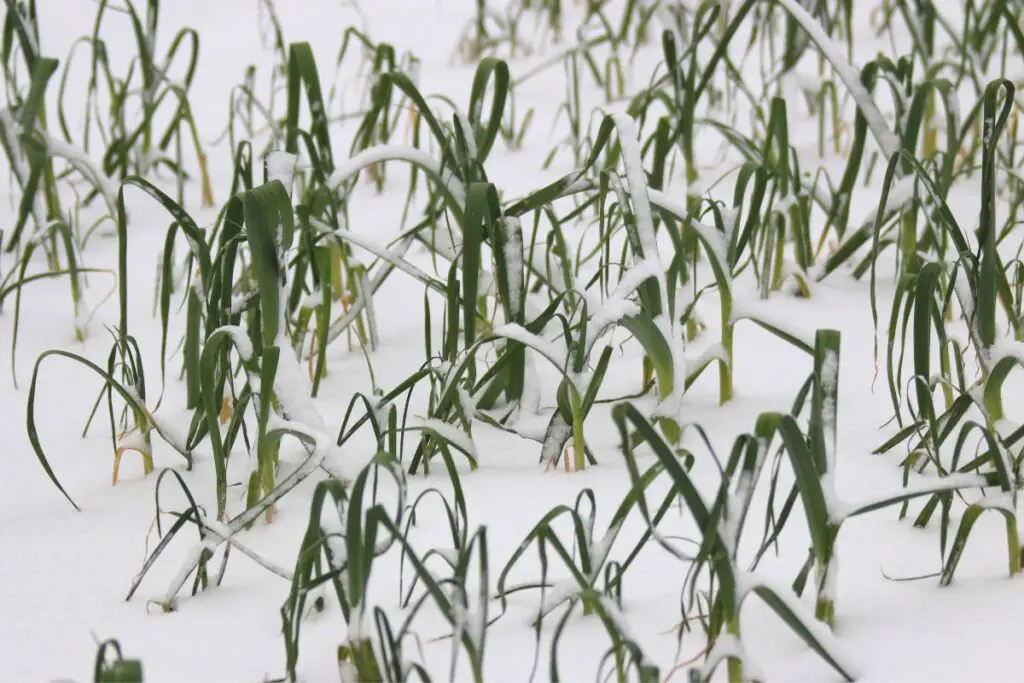
Will garlic plants survive frost?
Garlic is a great frost-tolerant plant.
You can grow them in zones 4-9 without any issues.
The garlic cloves will require some amount of cold during the winter season for vernalization.
It further helps trigger bulb development.
However, the soil temperature needs to be moderate.
Repeated heat or freeze can tear the young roots from the cloves, thus affecting the garlic growth.
The level of frost tolerance depends on the varieties.
Garlic has a lot of varieties and species.
But they are divided into two categories – Hardneck and Softneck varieties.
Hardneck varieties are native to the colder areas in zones 2-9.
Being cold-hardy, they perform best in the colder zones.
But Softneck varieties are native to the warmer climates.
So, they are not as hardy as the Hardneck varieties.
However, some Softneck varieties are cold-hardy, but most will suffer during the freezing temperatures.
The tops might get frozen.
But don’t worry as they will regrow.
How much frost can garlic handle?
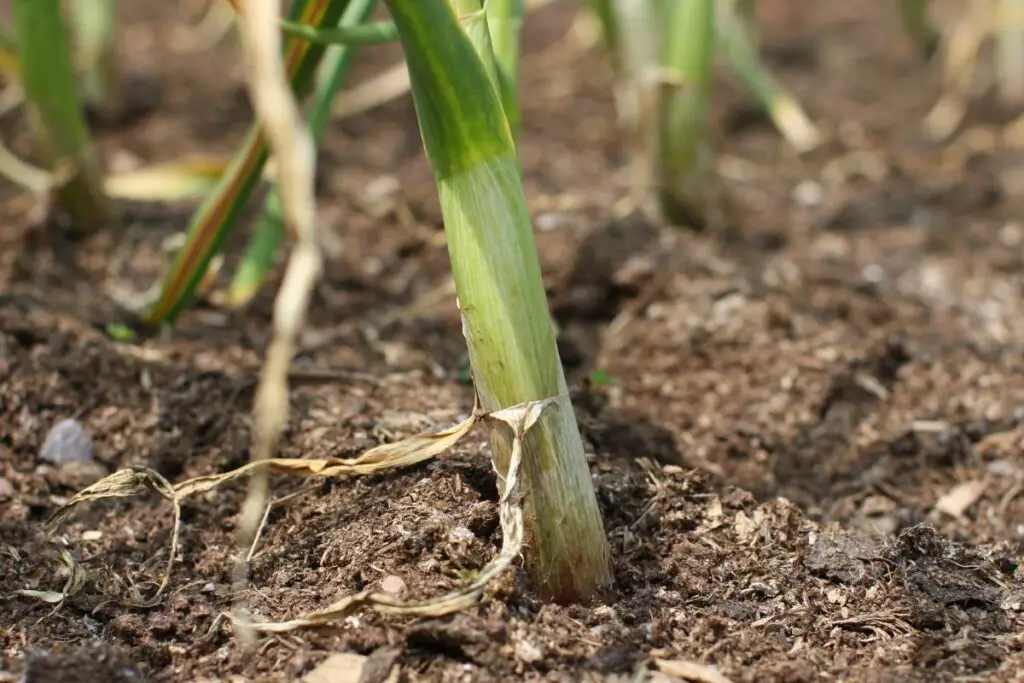
Garlic plants generally tolerate a cold temperature of around -30°F.
To be specific, it depends on the variety you grow.
Hardneck varieties are native to zones 2-9.
So, they can tolerate frosty weather better and survive temperatures below -20°F.
The average minimum temperature in zone 2 is -40°F.
Besides, Hardneck requires a prolonged cold temperature of around 40°F for vernalization, after which bulb development gets triggered.
This cold climate is more important when you grow Hardneck from seeds.
The seeds require temperatures of 40°F for 40 days to get vernalized.
Unless the seeds receive cold temperatures, germination will not trigger.
You can still grow Hardneck varieties in the warmer zones, provided they receive cold temperatures as low as 40-45°F.
For example, the German Red from Hardneck Rocambole variety is ideal for zones 8-12.
They will receive 10-15°F in winter for vernalizing and easily survive frost if any.
Softneck varieties are ideal for the warmer zones from 4-10.
They also can tolerate cold temperatures around -30°F.
Softneck varieties don’t require a cold temperature.
But a little bit of cold helps them to get stored well.
You can still grow a few Softneck varieties in the colder zones.
But you have to protect them by adding a layer of mulch.
For example, Sicilian from the Softneck Artichoke variety to zones 8-10.
So, you can grow them in slightly colder zones like 8.
These will tolerate temperatures around 10-15°F.
California Early and California Late are native to zones 6-12.
You can grow them in a colder zone like 6.
These Softneck varieties will also survive frost around 0°F to -5°F without any issues.
Looking for gardening supplies? We have tested 100's of products before recommending them to you guys. Check out our best pick below:
| Image | Gardening Supplies | Best Price? |
|---|---|---|
 Top
Top Top
Top | Raised Garden Bed Kit | Check On Amazon |
 | XLUX Soil Moisture Meter, Plant Water Monitor, Soil Hygrometer Sensor for Gardening, Farming, Indoor and Outdoor Plants, No Batteries Required | No Results |
 Top
Top Top
Top | 82 Pcs Garden Tools Set and Extra Succulent Tools Set | Check On Amazon |
 | Joeys Garden Expandable Garden Hose with 8 Function Hose Nozzle, Lightweight Anti-Kink Flexible Garden Hoses, Extra Strength Fabric with Double Latex Core, (50 FT, Black) | No Results |
 Top
Top Top
Top | Dual Chamber Compost Tumbler | Check On Amazon |
 Top
Top Top
Top | Sunnyglade Plant Stakes | Check On Amazon |
 Top
Top Top
Top | Organic Cold Pressed Neem Seed Oil | Check On Amazon |
 Top
Top Top
Top | Mighty Mint Gallon :-Insect and Pest Control Peppermint Oil | Check On Amazon |
 Top
Top Top
Top | Scotts DiseaseEx Lawn Fungicide | Check On Amazon |
 Top
Top Top
Top | Jacks Classic 20-20-20 All Purpose Fertilizer | Check On Amazon |
 Top
Top Top
Top | 30,000 Seeds Pollinator Attracting Wildflower Mixture | Check On Amazon |
 Top
Top Top
Top | Survival Vegetable Seeds Garden Kit-Over 16,000 Seeds | Check On Amazon |
How can I overwinter garlic during the frost?
To encourage the garlic to survive the winter and come back when spring arrives, you need to overwinter them.
- First, plant your garlic cloves in well-drained soil added with compost to make the soil good in drainage, retention, and nutrition.
- Now, plant the big cloves for big and healthy bulbs. Put each clove 2-4 inches deep and 5-6 inches apart.
- Water them well for 3-4 days.
- When the temperature begins to cool down, mulch them with 6 inches of straw, pine, grass clipping, and leaves. It will keep the soil warm and allow the roots to develop well.
- Stop watering and fertilizing during the winter. They will go dormant when the ground freezes and begin to rest. While resting, they won’t consume any moisture or nutrients. Let them overwinter.
- Add another 4-6 inches of mulch to prevent spring weeds from developing when the snow melts in the early spring.
- When the risk of frost gets over in spring, remove the mulches from the bed.
Do I need to cover my garlic for frost?
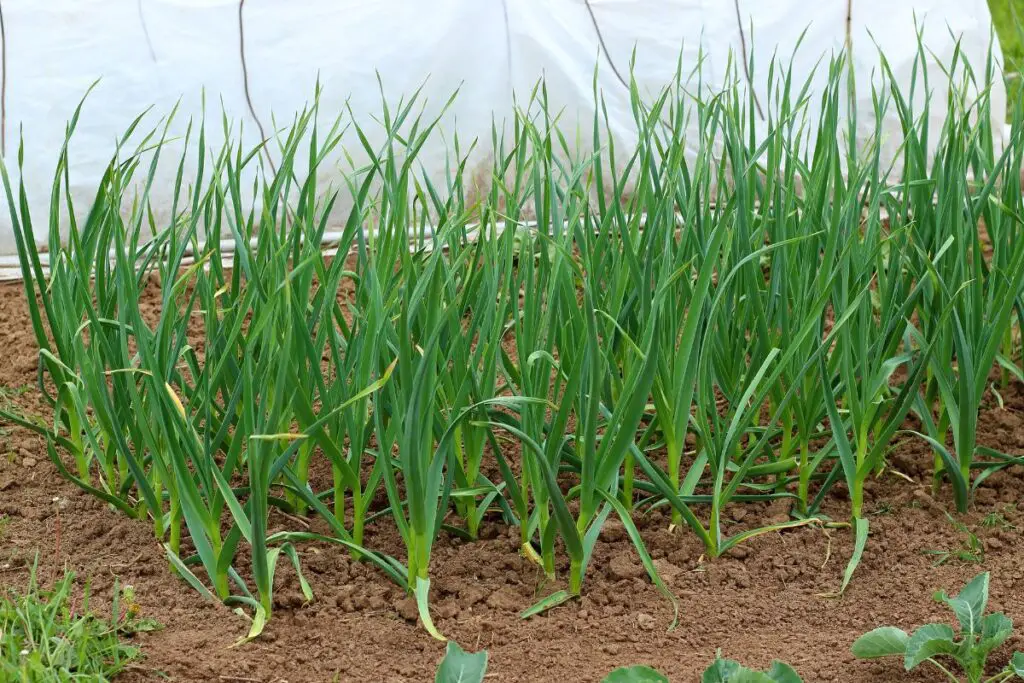
Generally, covering the bulbs with mulches is done to protect them from the winter frost.
It helps them get overwinter well and return in the next spring.
Besides, there are some good and valid reasons for covering the garlic soil bed.
In the winter, the temperature sometimes warms up, for which the garlic begins to grow and, suddenly, frost follows.
It is frost-heave.
Frost-heave is a condition where the plant receives a combination of frost temperature and soil defrost.
These fluctuating situations can result in deep soil cracks.
Plants may get uprooted before full development.
The plant will dry out and die if the under-developed roots get exposed to cold weather.
Covering also protects the young cloves from harsh frost, which can further displace the soil around the tender roots.
A hard frost can kill those tender roots.
Mulching the soil bed keeps the cloves safe till spring.
How to cover garlic during frost?
There are many ways to cover garlic:
Agrofiber: It is a synthetic materialized polypropylene film.
It doesn’t accumulate moisture, doesn’t freeze the garlic, and also gives them light.
Peat: Peat is a good heat-insulating ingredient.
It can save the cloves from extreme frost and also traps moisture.
Stopping watering won’t bother the cloves.
Fallen leaves: Dry and fallen leaves are easily-available covering materials that allow for adequate air passage.
But one demerit is they might have fungi and bugs we are unaware of.
Sawdust: It is another good mulch with a high thermal insulation range.
Besides, it can absorb and hold moisture.
But it is weak in warming up the ground.
Plant stems: Use only stems to cover.
It can hold the snow and prevent the soil from getting over moistened.
Can I grow garlic in winter?
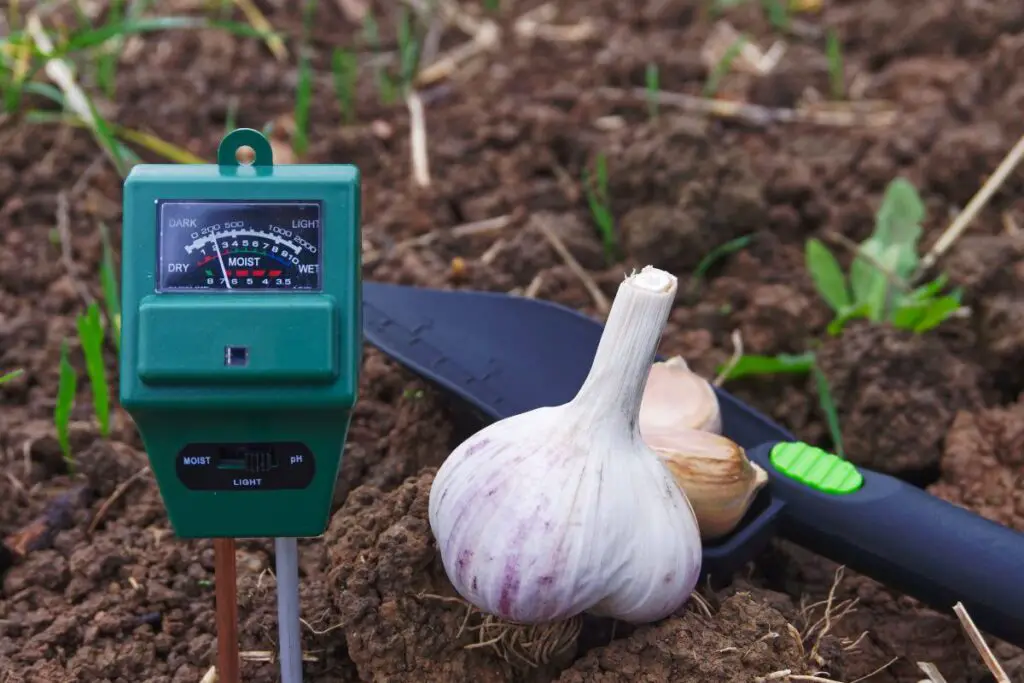
Generally, garlic cloves are planted in the fall to prepare for harvest in the spring and summer.
When winter arrives, the cloves need this cold to get vernalized, especially the Hardneck varieties.
If you belong to zones where temperatures rarely drop below 40-45°F, you can grow garlic in winter too.
This kind of temperature is required for root development.
Otherwise, the roots might get torn from the young cloves.
Besides, the plant will not grow new leaves if the cold weather does not pass.
It would be best to plant garlic before the first expected frost or at least 2-3 weeks before the ground freezes.
If your region rarely crosses 40-45°F, you don’t have to cover them.
But you have to mulch if the winter temperature ever reaches 13°F.
Not covering will affect root development if the cloves are planted only 2 inches deep.
So, mulching them will keep the roots warm and help them develop deeper throughout the winter.
Garlic prepares for harvest in the spring and summer when planted in the fall.
But, winter planting means late harvest.
So, winter-planted garlic will get ready to harvest after spring or summer.
You have to wait if the summer is too hot.
If the leaves of winter-planted garlic turn yellow in the spring, it doesn’t always mean that the garlic bulbs are ready for harvest.
It might indicate that they need more nitrogen.
To check whether the bulb is ready or not, dig only one bulb.
Be careful and try not to harm other bulbs.
The bulb should have a good size and should be intact.
The outer skins should develop well and get hardened.
A thin and easily damaged outer skin means it’s unripe.
And, split garlic means it got overripe.
Garlic growth conditions at different temperature ranges
At 12°F temperatures, the well-grown garlic tops will die.
At 5°F, the garlic tops, if small, will die.
If properly planted, the cloves can endure temperatures as low as -30°F.
The garlic roots will grow if the ground is warm.
The garlic tops will make new growth once the temperature is warm and goes above 40°F.
What happens if the garlic tops get frozen?
If the planted garlic tops have ever got frozen, don’t worry.
They will grow back once the temperature becomes normal.
The growth point is close to the bulbs, in or close to the soil, where the temperature is warm.
If your garlic plants or tops receive frost 1-2 times, expect less yield than those bulbs that did not receive any freeze.
If, by any chance, the fall climate during garlic planting got colder than usual, plant the cloves a little deeper or earlier.
But don’t plant garlic too early as the temperature will remain hot.
Garlic is a bit sensitive to summer hotness.
When to plant garlic?
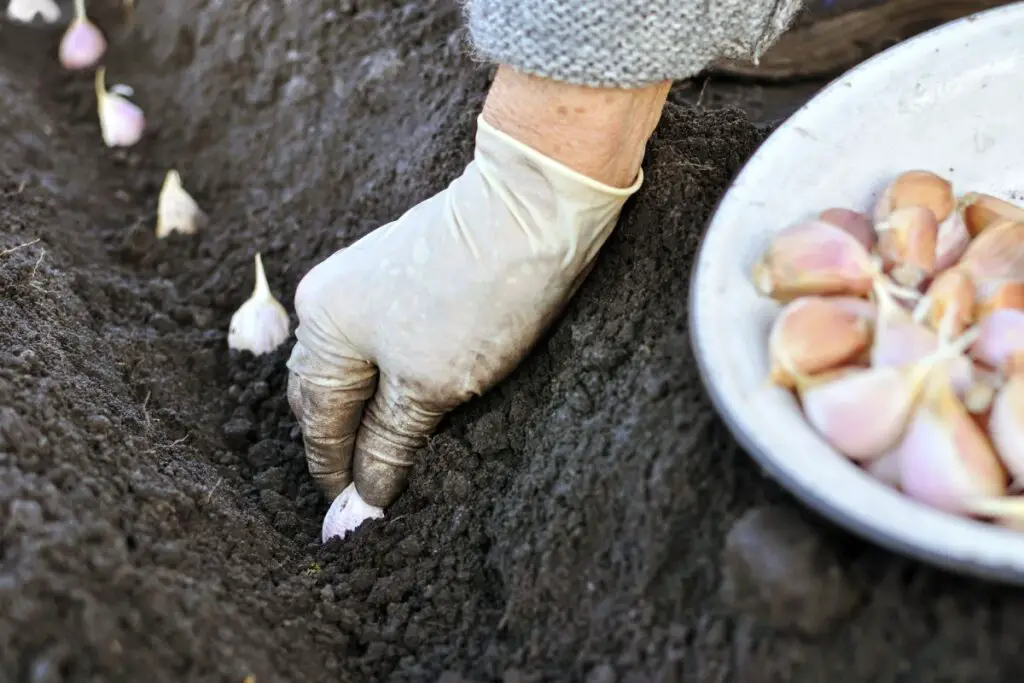
Both Hardneck and Softneck garlic varieties will perform best when planted in the fall.
After fall, the winter cold they get will help them trigger root development which is quite good for them.
However, since Softneck is native to warmer zones, they don’t require the cold temperature like the Hardneck varieties.
So, you can plant them in the spring too.
If you have ever missed fall planting, ensure that the garlic seeds receive 40°F temperature for 40 days before you plan to plant them.
Plant the cloves when the soil temperature is around 50°F.
If the temperature is still warm in the fall, wait for some more days for the temperature to cool down a bit.
If you are from cold areas, you should plant garlic 2-3 weeks after the first frost but 4-6 weeks before the ground has frozen.
Use well-drained soil mixed with some organic matter.
Plant the cloves 2-4 inches deep and water them well.
Protect them in winter by covering them with mulches, stems, sawdust, etc.
Check for the signs of yellow leaves in spring or summer.
Harvest when half of the leaves have turned yellow and dry.
Final thoughts
Garlic is an incredible frost-tolerant plant. Even if your garden gets filled with snow, with proper mulching, the garlic cloves will stay safe under the ground.
But don’t forget to mulch them. Cold can be harmful to tender roots. Mulching will keep warm even on the frozen ground.
It will help the roots to grow deep in the ground. Don’t water or fertilize your garlic when frost arrives. Once the snow begins to melt, remove the mulches.
If you are from colder regions, grow Hardneck varieties as they need the cold winter and are more cold-hardy than the Softneck. You can still grow Hardneck in warmer zones if they get the winter cold.
If you belong to Softneck varieties, grow them in the warmer zones because they don’t require cold temperatures. However, you can grow Softneck in colder regions only if you cover them well.
Reference: The Pennsylvania State University, Garlic Production for the Gardener, University of Massachusetts Amherst, Ohio State University Extension.
